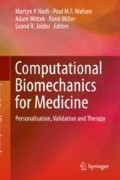Abstract
Numerical simulation is useful to help understand the behavior of pelvic system, and eventually to assist the diagnostic and surgery. Patient-specific simulation is expected to optimize the treatment of patients. Despite the requirement of mechanical properties and loading, patient-specific simulation requires first 3D geometry adapted to patient. Manual 3D reconstruction of the patient-specific anatomy is time-consuming and introduces uncertainties. In this paper, we propose an efficient computer-assisted approach to modeling 3D geometries well suited to MRI data. A well-controlled physical model is also proposed, and manufactured, to estimate uncertainties of the presented method.
Access this chapter
Tax calculation will be finalised at checkout
Purchases are for personal use only
References
Samuelsson EC, Victor FT, Tibblin G, Svärdsudd KF (1999) Signs of genital prolapse in a Swedish population of women 20 to 59 years of age and possible related factors. Am J Obstet Gynecol 180(2):299–305
Swift SE (2000) The distribution of pelvic organ support in a population of female subjects seen for routine gynecologic health care. Am J Obstet Gynecol 183(2):277–285
Bump RC, Mattiasson A, Bø K, Brubaker LP, DeLancey JO, Klarskov P, Shull BL, Smith AR (1996) The standardization of terminology of female pelvic organ prolapse and pelvic floor dysfunction. Am J Obstet Gynecol 175(1):10–17
Dell’oro M, Collinet P, Robin G, Rubod C (2013) Multidisciplinary approach for deep endometriosis: interests and organization. Gynecol Obstet Fertil 41(1):58–64
Mayeur O, Witz JF, Lecomte-Grosbras P, Brieu M, Cosson M, Miller K (2016) Influence of geometry and mechanical properties on the accuracy of patient-specific simulation of women pelvic floor. Ann Biomed Eng 44:202–212
Lorensen WE, Cline HE (1987) Marching cubes: a high resolution 3D surface construction algorithm. In: Proceedings of the 14th annual conference on computer graphics and interactive techniques SIGGRAPH ‘87, pp 163–169
Shekhar R, Fayyad E, Yagel R, Cornhill JF (1996) Octree-based decimation of marching cubes surfaces. In: Proceedings visualization ‘96, pp 335–342
Paragios N, Chen Y, Faugeras O (2006) Handbook of mathematical models in computer vision. Springer, New York
Kass M, Witkin A, Terzopoulos D (1988) Snakes: active contour models. Int J Comput Vis 1(4):321–331
Chan TF, Vese LA (2001) Active contours without edges. IEEE Trans Image Process 10(2):266–277
Li B, Acton ST (2007) Active contour external force using vector field convolution for image segmentation. IEEE Trans Image Process 16(8):2096–2106
Semin B, Auradou H, François M (2011) Accurate measurement of curvilinear shapes by virtual image correlation. Eur Phys J Appl Phys 56(1):10701
Réthoré J, François M (2014) Curve and boundaries measurement using B-splines and virtual images. Opt Lasers Eng 52:145–155
Jiang Z, Witz JF, Lecomte-Grosbras P, Dequidt J, Duriez C, Cosson M, Cotin S, Brieu M (2015) B-spline based multi-organ detection in magnetic resonance imaging. Strain 51(3):235–247
Jiang Z, Witz JF, Lecomte-Grosbras P, Dequidt J, Cotin S, Rubod C, Duriez C, Brieu M (2017) Multiorgan motion tracking in dynamic magnetic resonance imaging for evaluation of pelvic system mobility and shear strain. Strain 53(2):e12224
Bay T, Chambelland JC, Raffin R, Daniel M, Bellemare ME (2011) Geometric modeling of pelvic organs. Conf Proc IEEE Eng Med Biol Soc 2011:4329–4332
Vallet A, Witz JF, Rubod C, Brieu M, Cosson M (2011) Simulation of pelvic mobility: topology optimization of ligamentous system. Comput Methods Biomech Biomed Eng 14(1):159–163
Mayeur O, Lamblin G, Lecomte-Grosbras P, Brieu M, Rubod C, Cosson M (2014) FE simulation for the understanding of the median cystocele prolapse occurrence. In: Bello F, Cotin S (eds) Biomedical simulation, vol 8789, pp 220–227
Kikinis R, Pieper SD, Vosburgh K (2014) 3D slicer: a platform for subject-specific image analysis, visualization, and clinical support. In: Jolesz FA (ed) Intraoperative imaging image-guided therapy, vol 3(19), pp 277–289
Kamina P (2014) Anatomie clinique: Tome 4, Organes urinaires et génitaux, pelvis, coupes du tronc, 3rd edn. Maloine, Paris
Delancey JO (1992) Anatomic aspects of vaginal eversion after hysterectomy. Am J Obstet Gynecol 166(6):1717–1724
Piegl L, Tiller W (1995) The NURBS book. Monographs in visual communication. Springer, Basel
Buhmann MD (2003) Radial basis functions: theory and implementations. (Cambridge monographs on applied and computational mathematics). Cambridge University Press, Cambridge
Wendland H (2005) Scattered data approximation. Cambridge University Press, Cambridge
Botsch M, Kobbelt L, Pauly M, Alliez P, Levy B (2010) Polygon mesh processing. CRC Press Taylor & Francis Group, Boca Raton
Manzoni A, Quarteroni A, Rozza G (2012) Model reduction techniques for fast blood flow simulation in parametrized geometries. Int J Numer Methods Biomed Eng 28(6–7):604–625
Mongillo M (2011) Choosing basis functions and shape parameters for radial basis function methods. SIAM Undergrad Res Online 4:2–6
PyGeM: Python Geometrical Morphing. Available at: https://github.com/mathLab/PyGeM
Tezzele M, Salmoiraghi F, Mola A, Rozza G (2017) Dimension reduction in heterogeneous parametric spaces with application to naval engineering shape design problems. arXiv preprint arXiv:1709.03298
Jeanditgautier E, Mayeur O, Brieu M, Lamblin G, Rubod C, Cosson M (2016) Mobility and stress analysis of different surgical simulations during a sacral colpopexy, using a biomechanical model of the pelvic system. Int Urogynecol J 27(6):951–957
Mayeur O, Jeanditgautier E, Witz JF, Lecomte-Grosbras P, Cosson M, Rubod C, Brieu M (2017) Evaluation of strains on levator ani muscle: damage induced during delivery for a prediction of patient risks. In: Computational biomechanics for medicine. Springer, Cham, pp 135–146
Lepage J, Cosson M, Mayeur O, Brieu M, Rubod C (2016) Pedagogical childbirth simulators: utility in obstetrics. Eur J Obstet Gynecol Reprod Biol 197:41–47
Author information
Authors and Affiliations
Editor information
Editors and Affiliations
Rights and permissions
Copyright information
© 2020 Springer Nature Switzerland AG
About this paper
Cite this paper
Jiang, Z. et al. (2020). Patient-Specific Modeling of Pelvic System from MRI for Numerical Simulation: Validation Using a Physical Model. In: Nash, M., Nielsen, P., Wittek, A., Miller, K., Joldes, G. (eds) Computational Biomechanics for Medicine. Springer, Cham. https://doi.org/10.1007/978-3-030-15923-8_2
Download citation
DOI: https://doi.org/10.1007/978-3-030-15923-8_2
Published:
Publisher Name: Springer, Cham
Print ISBN: 978-3-030-15922-1
Online ISBN: 978-3-030-15923-8
eBook Packages: EngineeringEngineering (R0)

